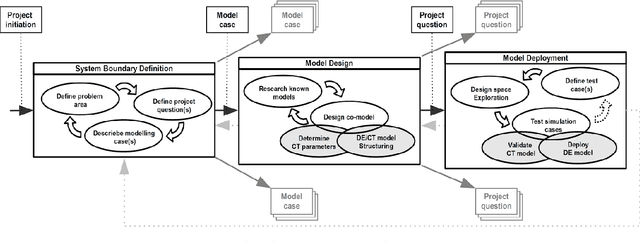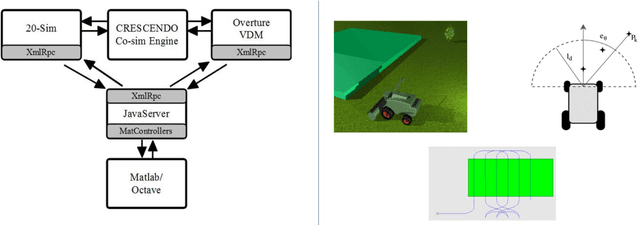Martin Peter Christiansen
Co-modelling of Agricultural Robotic Systems
Jun 17, 2019



Abstract:Automated and robotic ground-vehicle solutions are gradually becoming part of the agricultural industry, where they are used for performing tasks such as feeding, herding, planting, harvesting, and weed spraying. Agricultural machinery operates in both indoor and outdoor farm environments, resulting in changing operational conditions. Variation in the load transported by ground-vehicles is a common occurrence in the agricultural domain, in tasks such as animal feeding and field spraying. The development of automated and robotic ground-vehicle solutions for conditions and scenarios in the agricultural domain is a complex task, which requires input from multiple engineering disciplines. This PhD thesis proposes modelling and simulation for the research and development of automated and robotic ground-vehicle solutions for purposes such as component development, virtual prototype testing, and scenario evaluation. The collaboration of multiple engineering disciplines is achieved by combining multiple modelling and simulation tools from different engineering disciplines. These combined models are known as co-models and their execution is referred to as co-simulation. The results of this thesis are a model-based development methodology for automated and robotic ground-vehicles utilised for a number of research and development cases. The co-models of the automated and robotic ground vehicles were created using the model-based development methodology, and they contribute to the future development support in this research domain. The thesis presents four contributions toward the exploration of a chosen design space for an automated or robotic ground vehicle. Solutions obtained using co-modelling and co-simulation are deployed to their ground-vehicle realisations, which ensures that all stages of development are covered.
Ground vehicle mapping of fields using LiDAR to enable prediction of crop biomass
May 03, 2018



Abstract:Mapping field environments into point clouds using a 3D LIDAR has the ability to become a new approach for online estimation of crop biomass in the field. The estimation of crop biomass in agriculture is expected to be closely correlated to canopy heights. The work presented in this paper contributes to the mapping and textual analysis of agricultural fields. Crop and environmental state information can be used to tailor treatments to the specific site. This paper presents the current results with our ground vehicle LiDAR mapping systems for broad acre crop fields. The proposed vehicle system and method facilitates LiDAR recordings in an experimental winter wheat field. LiDAR data are combined with data from Global Navigation Satellite System (GNSS) and Inertial Measurement Unit (IMU) sensors to conduct environment mapping for point clouds. The sensory data from the vehicle are recorded, mapped, and analyzed using the functionalities of the Robot Operating System (ROS) and the Point Cloud Library (PCL). In this experiment winter wheat (Triticum aestivum L.) in field plots, was mapped using 3D point clouds with a point density on the centimeter level. The purpose of the experiment was to create 3D LiDAR point-clouds of the field plots enabling canopy volume and textural analysis to discriminate different crop treatments. Estimated crop volumes ranging from 3500-6200 (m3) per hectare are correlated to the manually collected samples of cut biomass extracted from the experimental field.
Robotic design choice overview using co-simulation
Feb 17, 2018



Abstract:Rapid robotic system development sets a demand for multi-disciplinary methods and tools to explore and compare design alternatives. In this paper, we present collaborative modeling that combines discrete-event models of controller software with continuous-time models of physical robot components. The presented co-modeling method utilized VDM for discrete-event and 20-sim for continuous-time modeling. The collaborative modeling method is illustrated with a concrete example of collaborative model development of a mobile robot animal feeding system. Simulations are used to evaluate the robot model output response in relation to operational demands. The result of the simulations provides the developers with an overview of the impacts of each solution instance in the chosen design space. Based on the solution overview the developers can select candidates that are deemed viable to be deployed and tested on an actual physical robot.
Collaborative model based design of automated and robotic agricultural vehicles in the Crescendo Tool
Feb 17, 2018



Abstract:This paper describes a collaborative modelling approach to automated and robotic agricultural vehicle design. The Cresendo technology allows engineers from different disciplines to collaborate and produce system models. The combined models are called co-models and their execution co-simulation. To support future development efforts a template library of different vehicle and controllers types are provided. This paper describes a methodology to developing co-models from initial problem definition to deployment of the actual system. We illustrate the development methodology with an example development case from the agricultural domain. The case relates to an encountered speed controller problem on a differential driven vehicle, where we iterate through different candidate solutions and end up with an adaptive controller solution based on a combination of classical control and learning feedforward. The second case is an example of combining human control interface and co-simulation of agricultural robotic operation to illustrate collaborative development
 Add to Chrome
Add to Chrome Add to Firefox
Add to Firefox Add to Edge
Add to Edge